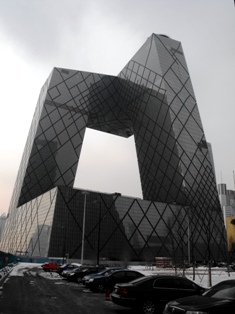Thus I went to the city of Taiyuan in Shanxi Province, some 500 kms in land from Beijing. The theme of the meeting was Historic Conservation, and it quickly became evident why this theme was chosen for this location. Shanxi has an immense number of historic buildings, most of them wooden and thus posing significant challenges for preservation. The conference itself was held in a hotel at the foot of the Hanging Jar Mountain and adjacent to the Jinci Temple. The first written record of this temple dates back over 1500 years ago. As well as the historic buildings which are still preserved, and trees over 3000 years old, there is an impressive natural feature. A hot spring, called the Never Aging Spring, meant that while the whole landscape was in the deep freeze of continental winter, the water from the spring flowed clear and bright and the canals, criss-crossed by bridges, were clear of ice.
My hosts also treated me to a trip to the historic walled city of Ping Yao, a World Heritage Site about 90 kms away. This city dates from the 14th century and still has its city walls in tact. These 30 metre high ramparts stretch 6kms around the city and have four entry gates. Inside the walls there are temples and public buildings but also the traditional courtyards in which extended families still conduct their life. Some of these courtyards have been converted to hotels. This has been done in a manner sensitive to the historic environment, and in general the town seems to have managed to contain the visual impacts of its influx of heritage tourists, not least from Europe.

I was also able to re-visit Beijing, where I gave a lecture at Tsinghua University. I had not been there for about 7 years, and was fascinated to see the famous “bird’s nest” Olympic Stadium and the Olympic Green and forest park that provide the setting for the stadium and follow the north-south axis that so defines the sight lines and structure of the city. These are not the only iconic (and hugely expensive) structures that had sprung up since my last visit. The Opera House and the CCTV building (234 metres high. See the picture on the left) are further examples of the use of eye-catching architecture to position the city on the global stage. The Opera House is dome shaped and sits surrounded by a shallow lake, with the entrance taking you beneath the water. It was designed by French architect Paul Andreu and has been nick-named “The Egg”. The CCTV building was also a design from Europe, by the Dutch form OMA.
While these spectacles grad the attention, some more mundane new buildings may prove more important in the long term. In the north west of the city, between the Fourth Ring Road and the Fifth Ring Road, and even beyond it, a vast knowledge hub has been constructed. Peking University and Tsinghua University, elite institutions themselves, were already located here. Tsinghua now has its business park, and there are lots of other rather ordinary plump modern high-rise blocks that house an array of research institutes: the Beijing Language University; the China University of Geosciences; the Beijing Science and Technology University, the Chinese Agricultural University; the China University of Petroleum to name just a few. Back in Ping Yao I had seen the examination scripts written by candidates to enter the civil service at a time when the people who ran most of Europe were chosen by birth not educational attainment. The high regard for education and academic ability is part of the legacy of Confucius: the examination system dated back to something like 200 BC.
In the UK at the moment the government is cutting back investment in higher education. It seems we cannot afford it, since we have to pay back the money borrowed to save the bankers and pay their multi-million Euro bonuses. Yet there remains the comforting notion in the West that our future lies in the knowledge economy, while China supplies us with trinkets and gadgets assembled by a low-paid, low-skilled work force. It’s not going to be like that. China is creating a cadre of high calibre graduates, fluent in English, and technologically smart. The sweat shops and assembly lines of the future will be located somewhere else: perhaps they will see a revival here in Europe.

